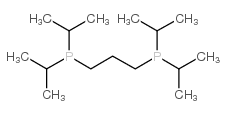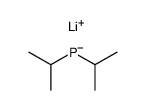91159-11-4
| Name | 1,3-bis(di-i-propylphosphino)propane |
|---|---|
| Synonyms | bis-1,3-diisopropylphosphinopropane |
| Molecular Formula | C15H34P2 |
|---|---|
| Molecular Weight | 276.37800 |
| Exact Mass | 276.21400 |
| PSA | 27.18000 |
| LogP | 5.97390 |
|
Section 1: Product Identification Chemical Name:1,3-Bis(di-i-propylphosphino)propane, min. 98% (dippp) CAS Registry Number:91159-11-4 Formula:(C3H7)2PCH2CH2CH2P(C3H7)2 EINECS Number:none Chemical Family:organophosphine ligand Synonym:1,3-Bis(di-2-propylphosphano)propane
Section 2: Composition and Information on Ingredients IngredientCAS NumberPercentACGIH (TWA)OSHA (PEL) Title compound91159-11-4100%no datano data Section 3: Hazards Identification Emergency Overview:Irritating to skin, eyes and respiratory tract. May be harmful if swallowed. Primary Routes of Exposure:Inhalation, skin, eyes Eye Contact:Causes mild to moderate irritation of the eyes. Skin Contact:Causes slight to mild irritation of the skin. Inhalation:Irritating to the nose, mucous membranes and respiratory tract. Ingestion:No specific information is available on the physiological effects of ingestion. May be harmful if swallowed. Acute Health Affects:Irritating to skin, eyes and respiratory tract. May be harmful if swallowed. Chronic Health Affects:No information on long-term chronic effects. NTP:No IARC:No OSHA:No SECTION 4: First Aid Measures Immediately flush the eyes with copious amounts of water for at least 10-15 minutes. A victim may need Eye Exposure: assistance in keeping their eye lids open. Get immediate medical attention. Wash the affected area with water. Remove contaminated clothes if necessary. Seek medical assistance if Skin Exposure: irritation persists. Remove the victim to fresh air. Closely monitor the victim for signs of respiratory problems, such as difficulty Inhalation: in breathing, coughing, wheezing, or pain. In such cases seek immediate medical assistance. Seek medical attention immediately. Keep the victim calm. Give the victim water (only if conscious). Induce Ingestion: vomiting only if directed by medical personnel. SECTION 5: Fire Fighting Measures Flash Point:no data Autoignition Temperature:no data Explosion Limits:no data Extinguishing Medium:carbon dioxide, dry powder or foam Fire fighters should be equipped with a NIOSH approved positive pressure self-contained breathing apparatus Special Fire Fighting Procedures: and full protective clothing. Hazardous Combustion andIf involved in a fire this material may emit toxic organic fumes. Decomposion Products: Unusual Fire or Explosion Hazards: Flammable. No unusual fire or explosion hazards. SECTION 6: Accidental Release Measures Spill and Leak Procedures:Remove sources of ignition. Small spills can be mixed with vermiculite or sodium carbonate and swept up. SECTION 7: Handling and Storage Store the material in a cool, dry place in a tightly sealed container. Handle and store under an inert Handling and Storage: atmosphere of nitrogen or argon. SECTION 8: Exposure Controls and Personal Protection Eye Protection:Always wear approved safety glasses when handling a chemical substance in the laboratory. Skin Protection:Wear protective clothing and gloves. Ventilation:Handle the material in an efficient fume hood. If ventilation is not available a respirator should be worn. The use of respirators requires a Respirator Respirator: Protection Program to be in compliance with 29 CFR 1910.134. Ventilation:Handle the material in an efficient fume hood. Additional Protection:No additional protection required. SECTION 9: Physical and Chemical Properties Color and Form:colorless to pale yellow liquid Molecular Weight:276.38 Melting Point:no data Boiling Point:no data Vapor Pressure:no data Specific Gravity:no data Odor:none Solubility in Water:insoluble SECTION 10: Stability and Reactivity Stability:air sensitive Hazardous Polymerization:no hazardous polymerization Conditions to Avoid:prolonged exposure to air Incompatibility:strong oxidizing agents, air, and halogens Decomposition Products:carbon monoxide, carbon dioxide, phosphorous pentoxide, organic fumes SECTION 11: Toxicological Information RTECS Data:No information available in the RTECS files. Carcinogenic Effects:no data Mutagenic Effects:no data Tetratogenic Effects:no data SECTION 12: Ecological Information Ecological Information:No information available SECTION 13: Disposal Considerations Disposal:Dispose of according to federal, state, and local regulations. SECTION 14: Transportation Shipping Name (CFR):Flammable liquids, N.O.S. Hazard Class (CFR):3 Additional Hazard Class (CFR):NA Packaging Group (CFR):II UN ID Number (CFR):UN# 1993 Shipping Name (IATA):Flammable liquid, N.O.S. Hazard Class (IATA):3 Additional Hazard Class (IATA):NA Packaging Group (IATA):II UN ID Number (IATA):UN# 1993 SECTION 15: Regulatory Information TSCA:Not listed in the TSCA inventory. SARA (Title 313):Title compound not listed. Second Ingredient:none SECTION 16 - ADDITIONAL INFORMATION N/A |
| Risk Phrases | 11 |
|---|---|
| Safety Phrases | 16-26-36/37/39 |
| RIDADR | UN 1993 |
|
~% 
91159-11-4 |
| Literature: Lindner, Ekkehard; Schmid, Markus; Wald, Joachim; Queisser, Joachim A.; Gepraegs, Michael; Wegner, Peter; Nachtigal, Christiane Journal of Organometallic Chemistry, 2000 , vol. 602, # 1-2 p. 173 - 187 |
|
~84% 
91159-11-4 |
| Literature: Tani, Kazuhide; Tanigawa, Eiji; Tatsuno, Yoshitaka; Otsuka, Sei Journal of Organometallic Chemistry, 1985 , vol. 279, p. 87 - 102 |
| Precursor 3 | |
|---|---|
| DownStream 1 | |




